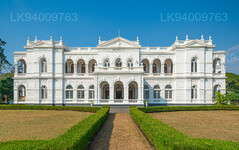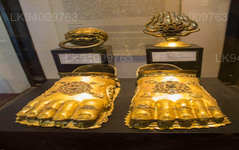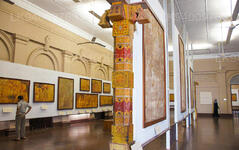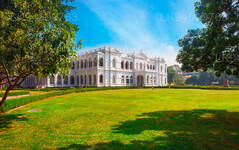
Město Kolombo
Kolombo, hlavní město Srí Lanky, je dynamické město, které mísí tradici s modernou. Představuje koloniální architekturu, živé trhy a klidné buddhistické chrámy. Díky rozmanité kuchyni, rostoucímu panoramatu a krásným plážím je pulzujícím centrem obchodu, kultury a cestovního ruchu a nabízí vstupní bránu k objevování krás Srí Lanky.
National Museum
National Museum of Sri Lanka: The House of History
The National Museum of Sri Lanka, also most commonly known as the Sri Lanka National Museum is cosidered to be the largest Museum in Sri Lanka. It is maintained by its own dedicated Department of National Museum in Sri Lanka. It is home to many valuable and historically important objects such as the throne and the crown of the Kandyan Monarchs.
National Museum of Sri Lanka: The Story behind the History
The Colombo Museum was established in 1st January 1877. It was founded by the British Governor of Ceylon at the time; Sir William Gregory.
The architect of the Public Works department, J.G. Smither was able to prepare plans for the new structure based on Italian architecture style.
The construction of the Museum was carried out by Arasi Marikar Wapchie Marikar (born 1829, died 1925, aka Wapchi Marikar Bass. Wapchi Marikar Bass has an extensive resume that made him the perfect man for this immense project. He was the builder of the General Post Office in Colombo, Colombo Customs, Old Town Hall in Pettah, Galle Face Hotel, Victoria Arcade, Finlay Moir building, the Clock Tower, Batternburg Battery and many other buildings some of which are still standing today. The construction was completed in 1876 and commissioned to be opened the following year. The completed building of the Colombo Museum was declared open by Governor Gregory, in the presence of a large crowd.
Several other wings were added from time to time under the direction of Dr. Arthur Willey and Dr. Joseph Pearson new structures were built during the period of Dr. P. E. P. Deraniyagala, Dr. P. H. D. H. de Silva and Sirinimal Lakdusinghe. One of the natural history museum, and yet another consists of the auditorium.
National Museum of Sri Lanka: Recent developments
The museum was given the status of a national museum during the period of P. E. P. Deraniyagala. Under his supervision branch museums were opened in Jaffna, Kandy, and Ratnapura and a fully-fledged department of national museum was established in 1942 under the act No. 31. Nine branch museums were ultimately opened, and a school science program and a mobile museum law essay writing uk service are also in operation.
National Museum of Sri Lanka: The Library
Along with the Colombo National Museum the Library was also established in the 1st of January in 1877. The Government Oriental library (1870) was incorporated in to Colombo National Museum Library, and served as the nucleus of the library collection by collecting the local publications during the past 129 years.This huge collection of the library could be separated in to various groups according to the document type.
1. Palm leaf collection which are written in Sinhala, Pali, Sanskrit, Burmese, Telegu and Tamil characters among the subjects covered are Buddhism, Sinhala literature, History, Indigenous Medicine, Astrology, Demonology, Veterinary Science, Art, Architecture and Folklore.
2. Printed books and Pamphlets, This collection comprises the entire range of documents from the first work printed in 1737 to the latest book.
3. Periodical collections such as Journal of the Royal Asiatic Society (CB), Ceylon Antiquary and Literary Register, Young Ceylon etc. The collection was built up to a great extent by exchanges received from the institutions in all parts of the globe. Foreign periodical collection contains important titles such as discovery reports, Ray Society publications among many others.
4. Government Publications such as Blue books from 1864-1938, Administration Reports from 1867 to date, Sessional papers from 1860 up to date, Hansards
from 1863-1962 etc.
5. Directories, Statistical year books, Trade catalogues etc.
6. Law Reports
7. Maps and Drawings
National Museum of Sri Lanka: Photography Division
The Photography Division of the Department of National Museums was established in 1950. Photographs related to the museum objects supply to other divisions of the department and external parties is the main task of this division.
Services of this division are:
Photograph museum objects, faunal and floral specimen, geological items and supply photographs to the relevant divisions where necessary. Sale of photographs of museum objects to external parties with the orderly approval from the Director. Negatives, photographs taken by the digital camera store on CD’s, registration and conservation.
National Museum of Sri Lanka: Information Technology division
The Information Technology division of National Museum of Sri Lanka is used to archive the all the data in the Museum and save it in a safe form. It also takes care of online queries and maintaining the museum web page.
O okrese Colombo
Kolombo je největší město a obchodní centrum Srí Lanky. Nachází se na západním pobřeží ostrova a sousedí se Srí Džajavardanepura Kotte, hlavním městem Srí Lanky. Kolombo je rušné a živé město se směsicí moderního života, koloniálních budov a ruin a má 647 100 obyvatel. Metropolitní region Kolombo, vymezený okresy Kolombo, Gampaha a Kalutara, má odhadovanou populaci 5 648 000 a rozkládá se na ploše 3 694,20 km². Kolombo je multietnické a multikulturní město. Je to nejlidnatější město na Srí Lance, v jehož městských hranicích žije 642 163 lidí. Počet obyvatel Kolomba je směsicí mnoha etnických skupin, zejména Sinhálců, Maurů a Tamilů. Ve městě žijí také malé komunity lidí čínského, portugalského, nizozemského, malajského a indického původu, stejně jako četní evropští emigranti. Velká většina srílanských společností má svá ústředí v Kolombu. Mezi průmyslová odvětví patří chemický, textilní, sklářský, cementářský, kožený, nábytkářský a šperkovský průmysl. V centru města se nachází druhá nejvyšší budova v jižní Asii - Světové obchodní centrum.
O Západní provincii
Západní provincie je nejhustěji osídlenou provincií Srí Lanky. Nachází se zde hlavní město zákonodárného sboru Sri Jayawardenepura Kotte a také Colombo, administrativní a obchodní centrum země. Západní provincie se dělí na 3 hlavní okresy s názvem Colombo (642 km²), Gampaha (1 386,6 km²) a Kalutara (1 606 km²). Město je ekonomickým centrem Srí Lanky a sídlí zde všechny hlavní místní i mezinárodní korporace, stejně jako všichni hlavní designoví a maloobchodní prodejci, takže se připravte na nákupní terapii v západní provincii. Západní provincie má nejvyšší populaci ze všech provincií a téměř všechny přední vzdělávací instituce na ostrově se nacházejí v ní. Mezi univerzity v provincii patří Univerzita v Colombu, Univerzita Sri Jayewardenepura, Univerzita v Kelaniya, Otevřená univerzita na Srí Lance, Buddhistická a pálijská univerzita na Srí Lance, Univerzita obrany generála sira Johna Kotelawaly a Univerzita v Moratuwě. Západní provincie má největší počet škol v zemi, včetně národních, provinčních, soukromých a mezinárodních škol.










































